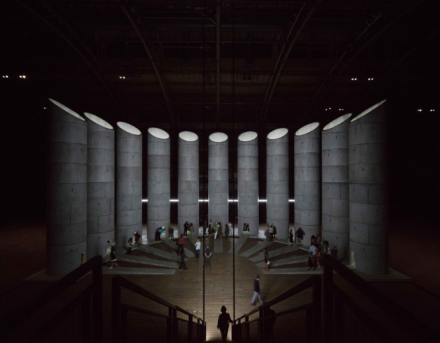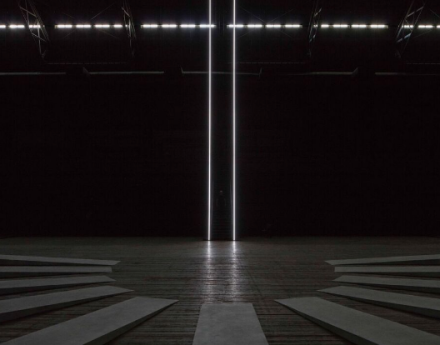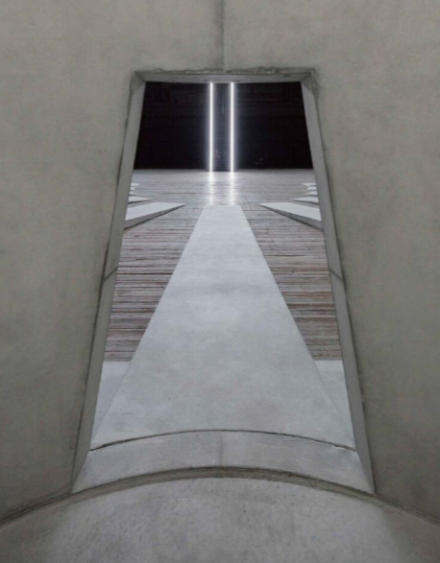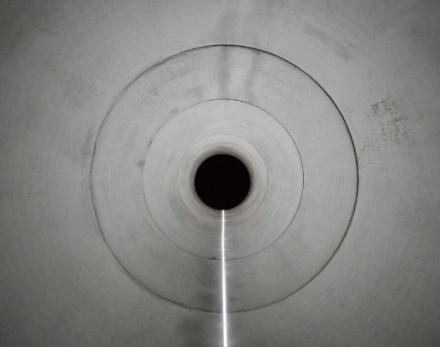
Taryn Simon, An Occupation of Loss (Installation View), courtesy Park Avenue Armory Image © Naho Kubota
In the midst of the Park Avenue Armory, a series of immense silos tower up from the floor, part of artist Taryn Simon’s landmark performance An Occupation of Loss, which brings a series of funeral mourners from around the globe to the Drill Hall for an overwhelmingly powerful performance meditating on loss, political agency, and common human experience.

Taryn Simon, An Occupation of Loss (Installation View), courtesy Park Avenue Armory Image © Naho Kubota
The show draws on the concept of loss, as framed by public expression and commodification of grief. Hiring a group of 30 professional mourners from Burkina Faso, Cambodia, Russia, Venezuela, and other countries around the globe, one is presented with the various pageantries of grief presented around the globe. In one room, a woman from Ghana weeps and wails, occasionally using a rag to dry her eyes, while in another, an accordionist from Ecuador plays a lament in several improvisatory parts. In a another space, a trio of Greece mourners perform a sort of musical wail, combining their own musical performance with a wavering vocal approach that infuses the work with sadness.

Taryn Simon, An Occupation of Loss (Installation View), courtesy Park Avenue Armory Image © Naho Kubota
The show is indescribably stark in this encounter with the performance of loss, with many visitors visibly disturbed or moved to tears. Each performer, trained in the expression and amplification of grief, commands the space they are in, yet the combined affect of their performances, each echoing out of the cement tubes that they perform within, creates an overwhelming totality of grief. Considering each performers’ attempts at mediating loss and sadness, the combined musical and vocal lamentations ultimately create a rich fabric of variants on the experience of loss. Some performers push the catharsis of their mourning through long, powerful wails of the voice, while others rely on an almost chaotic approach to counterpoint, each element colliding with the others in a manner that mirrors a certain sense of confusion and sadness. It’s perhaps the only way one could experience a full range of the emotions expressed at the death of a loved one at a single moment.

Taryn Simon, An Occupation of Loss (Installation View), courtesy Park Avenue Armory Image © Naho Kubota
Like much of Simon’s best work, the political content of her research and practice is threaded subtly with the raw aesthetic modes that her agents and actors work within. These are artists versed explicitly in the evocation and conveyance of loss, of the feeling of absence and the passage time that outpaces any easy classification of art in the Western canon. Their craft is the ability to dig at the heart of those present for their performances, and their ability to render this effect in the midst of the Drill Hall is an impressive testament to their talents. Yet their status as immigrants, emphasized by a text accompanying the work that shows a number of performers blocked from entering the country, underscores the regulation of their bodies on a political scale. Performers from politically fraught regions, or underdeveloped nations are often denied entry, leaving one to contend with the administration and limitation of their bodies despite the universality and deep emotional resonance of their craft.

Taryn Simon, An Occupation of Loss (Installation View), courtesy Park Avenue Armory Image © Naho Kubota
Ultimately, this sudden punch of grief contends with the lasting awareness of these performers’ political agency in contention with their immense skills. Viewers must contend with the political status and marginalized status of these performers, while almost simultaneously being exposed to the weight of their abilities. Simon offers the stage to a group of artists versed in a mode of catharsis that feels quite in line with the earliest threads of Greek theatre, of instilling powerful responses as a mode of psychological healing, and as a result, allows a certain history of the world through the frame of emotion itself, both in its political and performative capacities. The question that remains, as viewers fan out into the streets of the Upper East Side, is how we, as Americans, are active in this history.
Simon’s show remains on view through September 25th.
— D. Creahan
Read more:
Taryn Simon: An Occupation of Loss [Park Ave Armory]



